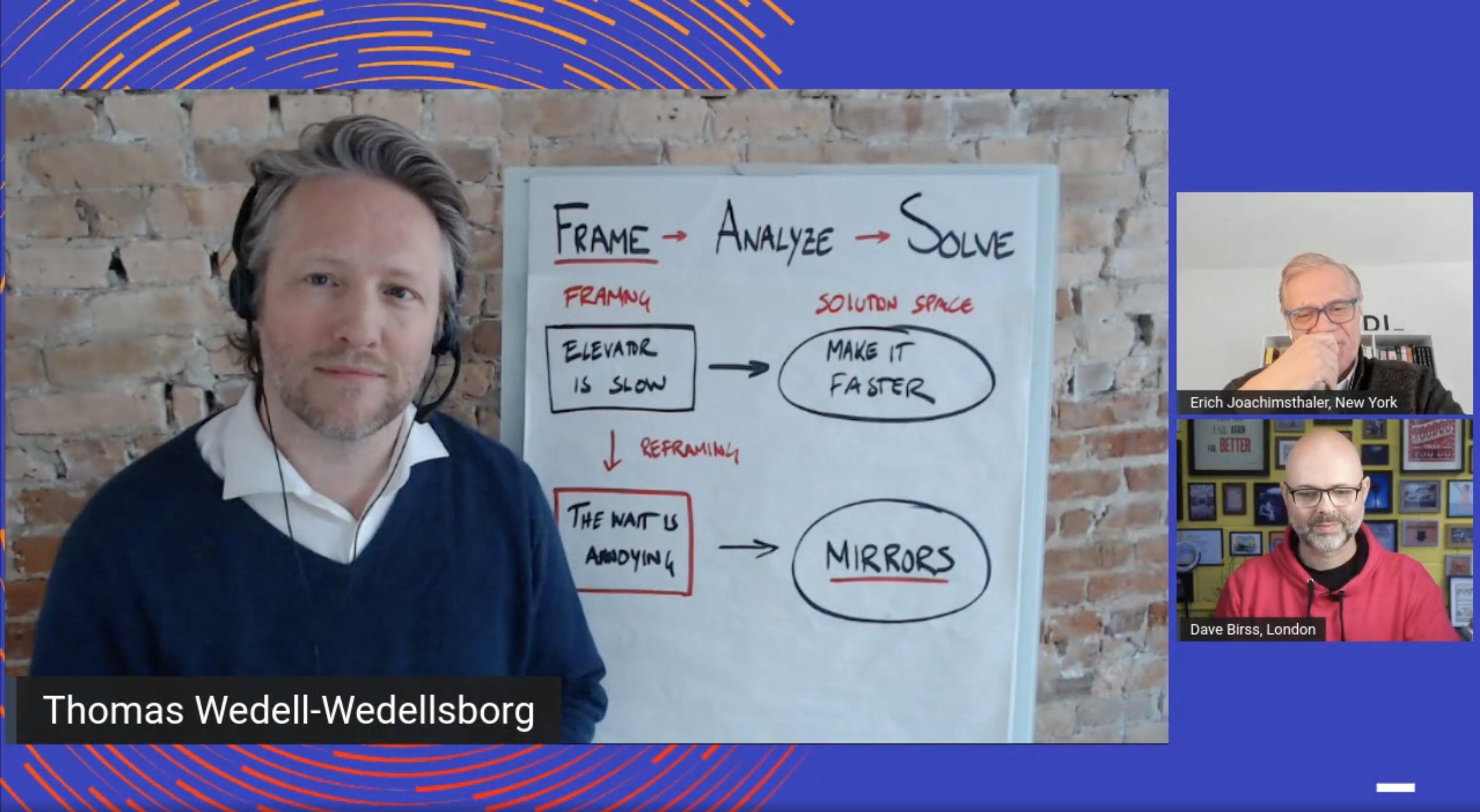Are you solving the right problems? Have you or your colleagues ever worked hard on something, only to find out you were focusing on the wrong problem entirely? The consequences are severe: Leaders fight the wrong strategic battles. Teams spend their energy on low-impact work. Startups build products that nobody wants. Organizations implement “solutions” that somehow make things worse, not better. Everywhere you look, the waste is staggering. Thomas Wedell-Wedelsborg, a globally recognized expert on problem solving and innovation joined our CEO, Erich Joachimsthaler, to discuss the framework for individuals and organizations to solve the right problems.

Here are some key principles from Thomas Wedell-Wedelsborg:
- The challenge is to solve unarticulated needs from consumers and the answer lies in framing the problem. The methodology taught at school or work for problem-solving often involves only two components namely, analysis and then solving it. However, the missing link here is ‘framing the problem’ and the missing skill is a higher-level ability to recognize the right problems.
“The job of the innovator or the problem solver is not to solve or analyze the problem but take a step further back and identify what is the right problem to solve. The core skill is to make sure we solve the right problems through framing and reframing them correctly.” – Thomas Wedell-Wedelsborg
2. The problem-solving loop continues even after your business is successful. Thomas references the classic failures of Nokia as an example. Stephen Elop, Nokia’s ex-CEO addressed his team about their failures in solving the wrong problem and focusing on making better hardware phones whereas Apple successfully built an ecosystem. This was a missed opportunity that ultimately led to Nokia’s demise.
“It’s not a linear process, don’t just define the problem, then go solve it. It is a loop between the three elements (framing, analyzing, and solving). This continues even after you have a successful business.” – Thomas Wedell-Wedelsborg
3. Organizations and individuals don’t live in isolation, they live in context and context is constantly changing. Organizations must question if they are exposed to what’s going on in their consumer’s world and the measures necessary to incorporate that information into their decision-making. As an individual, it is important to evaluate what you are spending your time on to absorb new information and what’s going on in the marketplace.
“[Understanding context] places a much greater emphasis on organizations and your listening apparatus, not just your mentality of trying to make sure what’s going on but how you actually do it.” – Thomas Wedell-Wedelsborg
Here are the three simple steps to solve problems more effectively:
- Get one or two people you work with to understand what you are talking about. It is very helpful to work with a colleague on a problem together. It is an individual skill but it is that much harder to do without the cooperation, understanding, and perspective of another team member who understands what you are talking about.
- If you really want to be successful, you need to start thinking about problem creation. Even when there is no potential problem in sight, examine possible implications where you’re going in and completely breaking new ground.
- Consideration of rapid changes in business model innovation demands a higher level of reflection. Before diving into problem-solving, understand what is happening in the ecosystem and identify any missed opportunities, reevaluate the roles of other participants.
Conclusion
As business models evolve and we move towards a more digital future, traditional problem-solving methodologies might no longer be successful. Thomas’s three-step framework – Frame, Reframe, Move Forward – unearths not only how to identify the right problems but how business leaders can solve them to unlock success. Developing a sharp problem-solving acumen is not only instrumental for solving customer pain points but also making breakthrough innovation.
Watch the full event here:
6:05: Reframing: How to solve the right problem
9:50: How to reframe to solve consumer problems
12:45: Success of Domino’s
13:40: Using technology to solve a problem
16:45: How Barkbox succeeded
22:30: How interaction field aligns with problem-solving
30:25: Problem-solving is a loop
44:47: Advice for effective problem solving
This segment was part of The Interaction Field Series of our LinkedIn Live Events. Please connect with us on our LinkedIn page to stay updated with our upcoming conversations.
